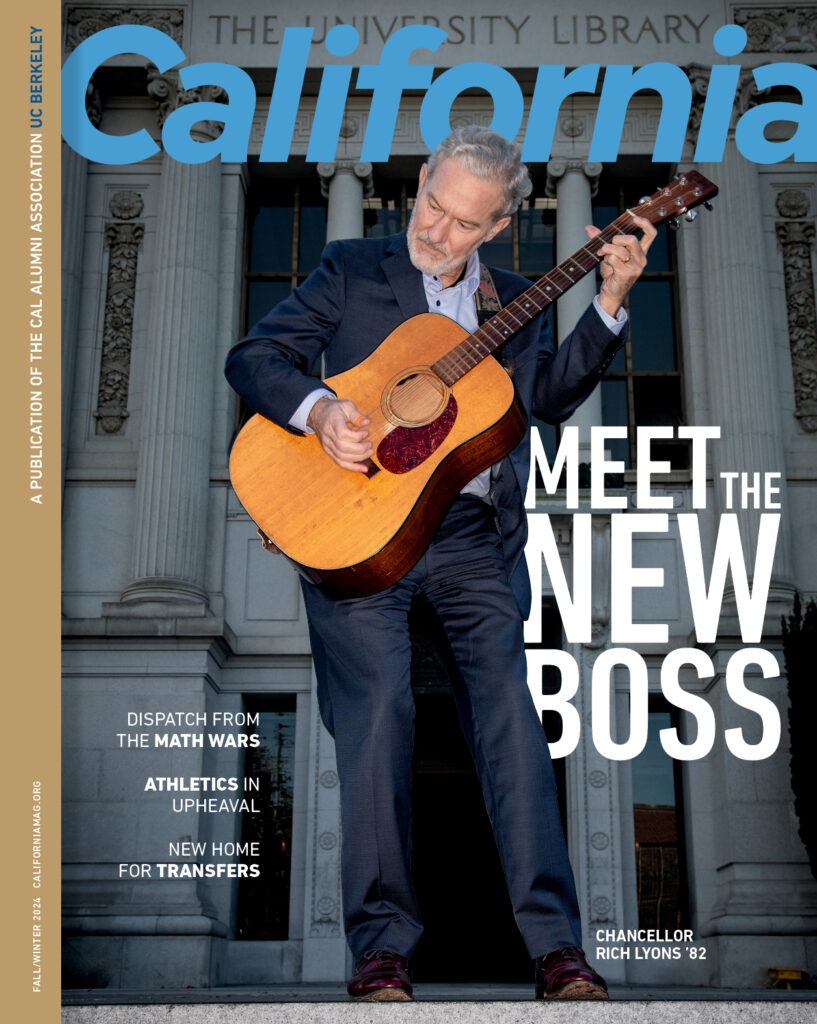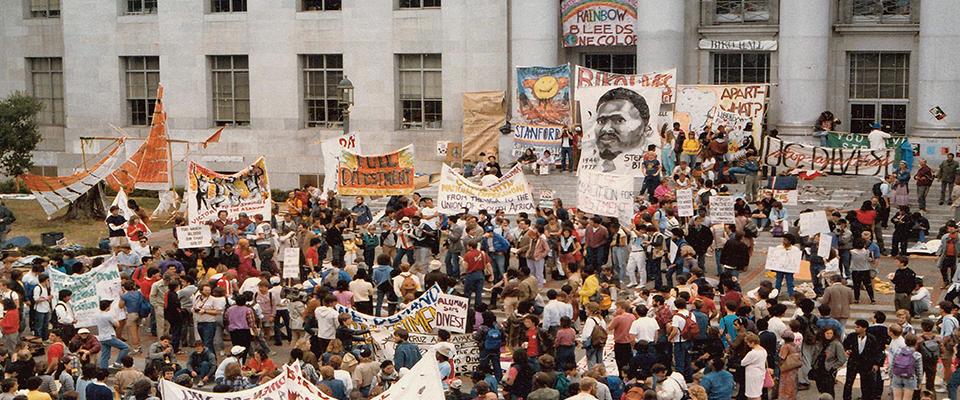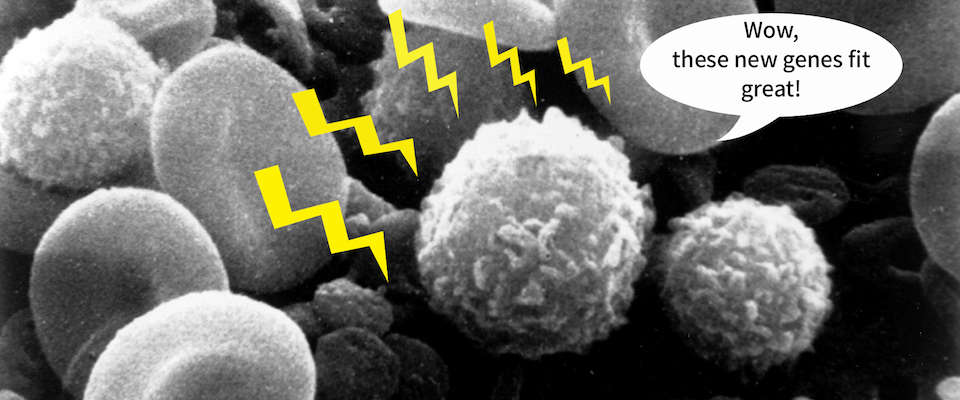When Nelson Mandela died last December, it seemed that the whole world mourned his passing. Twitter overflowed with love for the former South African president. South Africans of all colors and ages sat vigil outside his Johannesburg home. Leaders from Afghanistan to Zimbabwe traveled to FNB Stadium to memorialize Africa’s secular saint, and Barack Obama told the assembled dignitaries, “Nelson Mandela reminds us that it always seems impossible until it is done.”
Indeed, 30 years earlier the prospect of a free South Africa was almost unimaginable. Mandela had been imprisoned for decades. Although black townships from Cape Town to Durban were in open revolt against the white-run government, the regime had all the money and firepower it needed to keep the rebellion in check. It also enjoyed the full-throated support of the administrations of Ronald Reagan and Margaret Thatcher, who considered Mandela a Communist terrorist.
It was against that backdrop in April 1985 that a few dozen anti-apartheid students launched a sit-in at the entrance to Berkeley’s Sproul Hall. They hung banners, organized teach-ins, and, as night fell, unfurled sleeping bags on the steps. Within days, hundreds were sleeping there overnight, and thousands were turning out for midday rallies.
A banner above the steps spelled out their demand:
END UC TIES TO APARTHEID
CALL TO DIVEST
The UC system had billions invested, mostly through its endowment and pension funds, in companies doing business in South Africa. With a call for divestment, activists aimed to shame the University, pressure American lawmakers and corporations, and ultimately undermine the apartheid government in Pretoria. It was a strategy that struck many as naïve. In a scathing newspaper column, the conservative pundit George Will mocked the campaigners’ “self-regarding fastidiousness about their own moral hygiene” and dismissed their tactics as “a moral hula hoop, a fad, fun for a while.”
In fact, the push for divestment had begun decades earlier as a natural extension of the Civil Rights struggle. Martin Luther King Jr., drawing obvious parallels between Jim Crow and apartheid, had called for economic sanctions as far back as 1962. In 1965, Students for a Democratic Society (SDS) protested Chase Manhattan Bank for its loans to South Africa. And Berkeley’s Congressman Ron Dellums introduced the first of his many divestment resolutions on Capitol Hill in 1971. It had just one co-sponsor, and Dellums recalled that it was widely derided as “a Berkeley commie pinko plot.” Eight years later, the City of Berkeley would become the first municipality in America to divest.
But there was little support in Washington for such measures. Citing Cold War realpolitik, the Reagan administration drew closer to Pretoria, announcing a new policy of “constructive engagement”—officially a commitment to reform, but in practice an acceptance of the status quo. Most corporations, meanwhile, washed their hands of the matter entirely. As the chairman of Chase Manhattan put it, in response to the SDS-led bank boycott, “We can’t be responsible for the social affairs of a country. Where there’s commerce and trade, we feel we should be part of it.” The University took a similar position. In 1977, after the regents rejected a divestment proposal by Lt. Governor Mervyn Dymally, UC Treasurer Owsley Hammond told the Oakland Tribune, “An extremely dangerous precedent would be set if the regents were forced to base their investment philosophy upon the political or moral beliefs of certain segments of the population.”
With the 1985 sit-in, the Berkeley student body not only took its place at the forefront of a growing anti-apartheid movement that included churches, labor unions, and campuses across America, but also rekindled the campus’s largely dormant activist spirit. For years, Berkeley had been politically quiescent, but the divestment movement now became a rallying point for a new generation of protesters, a banner-waving rebuke to the popular notion that the “Reagan Revolution” had turned even the most radical college campuses complacent. Jonathan Simon, now the director of Boalt’s Center for the Study of Law and Society, was an activist law student at the time. He describes the first big anti-apartheid rally at Sproul. “You could see a strength that hadn’t been there for years. The crowds looked like pictures I had seen from the 1960s.”
“We didn’t invest in South Africa because of apartheid; I thought we shouldn’t divest because of it.” – David Gardner, former UC President
South Africa wasn’t the only hot-button issue of the day—students also protested CIA involvement in Central America—but the University’s extensive holdings brought the apartheid issue closer to home. Ross Hammond, a student leader and senator with the Associated Students of the University of California (ASUC) who now works for the environmental nonprofit ForestEthics, remembers his own awakening: “It wasn’t some abstract thing happening on the other side of the world. My university was making money off of it.”
The issue also presented students with a stark moral choice, as the nightly news beamed images of white police beating black protesters with truncheons, and armored trucks trundled through burning townships into American living rooms. Pedro Noguera, Cal student body president in 1985–86 and now a professor of sociology at New York University, recalls, “It just looked so familiar to Americans. It looked like Bull Connor.”
The truncheons would soon come out at Berkeley, too.
About a week into the sit-in, legions of police in riot gear descended on the camp just before dawn, arresting 158 protesters—the largest mass arrest on the Berkeley campus since the Vietnam era. The cops were still handcuffing people when students arrived for classes at 8 a.m.
The crackdown only intensified the protests. More than 10,000 students boycotted classes the next day, and thousands of faculty, staff, and students rallied in Sproul Plaza. Berkeley middle-school teacher Andrea Prichett ’85 was a student leader who became a lifelong activist; she recalls, “After we started sleeping on the stairs, people started talking about the ‘anti-apartheid movement.’ And we thought, ‘Oh, we’re a movement now?’ It felt like we went from a group to a movement overnight.”
Cal activists such as Nancy Skinner, now a member of the California Assembly representing parts of the East Bay, began recruiting celebrities—Maya Angelou, Alice Walker, Whoopi Goldberg—to blockade the chancellor’s office at California Hall. “We’d call the Great American Music Hall or Cal Arts to see who was in town,” says Skinner. “Then we’d ask them if they’d like to get arrested. Lots of them did.”

The movement spawned its own underground newspaper, The Biko Plaza News. Produced in counterculture co-op Barrington Hall, the punk-style ’zine ran protest schedules and revolutionary agitprop and issued news bulletins. It also published information about campus police. One item alleged that the “tall, blond cop with the long, thick blond mustache” had threatened a protest leader: “‘If I ever see you in a dark alley or alone at night, I’ll smash your head in.’”
Despite the growing tension, the campaign’s numbers continued to swell—a rally at Harmon Gym that spring drew 7,000 to watch a series of speakers address the regents, a few of whom were seated in the front row. The cause had gone mainstream. “You could walk down the street with a red ribbon,” says Prichett, referring to the ribbons that became the symbol of the movement, “and the ice cream place would give you a free ice cream.”
The Board of Regents, however, hadn’t changed their position. Nor had UC President David Gardner. “We didn’t invest in South Africa because of apartheid; I thought we shouldn’t divest because of it,” he said in a 1998 interview. “We allowed the political rhetoric to dominate the debate,” he continued. “And the political rhetoric was, in effect, a bumper-sticker approach to the issue.”
In May 1985, the regents convened at the heavily fortified Lawrence Hall of Science to consider the issue. About 1,500 protesters, some carrying black coffins, followed the regents the mile-and-a-half up the hill, chanting slogans like “Apartheid kills while UC counts its dollar bills.” In the end, the regents voted to create a committee to evaluate companies individually, to determine if they were behaving ethically in South Africa.
Neither side showed much restraint. “I’ve seen riots, with people breaking windows,” Pritchett remembers. “But I’ve never seen a battle like that.”
“They did all the things that large institutions do to avoid doing the right thing,” says Ross Hammond. “They knew they were on the wrong side of history. But they had to be dragged along kicking and screaming.”
Pressure continued to build both nationally and locally. By the spring of 1986, Oakland, Richmond, and San Francisco had begun selling off their South African holdings. So had more than two dozen universities, including Columbia, the University of Michigan, and Georgetown.
After nine months, though, the UC regents’ special committee had divested from just a single company (electrical equipment maker Eaton), and the protesters’ frustration was mounting. Relations between activists and the administration had become, as one administrator recalled, “sticky and tense.”
The first shanties appeared outside the chancellor’s office at California Hall at the end of March, 1986. Students built 15 crude structures from scavenged plywood and covered them in slogans. The idea, which began at Cornell and soon spread across the country, was to bring home to Americans the abysmal living conditions of poor black South Africans. At Berkeley, it also upped the ante by blocking access to the chancellor’s office. “We wanted to escalate the conflict,” Prichett says. “That meant daring the University to stop us.”
Protesters got their wish. The administration immediately declared the shanties “a major safety hazard” and ordered them destroyed. On April 1, police raided the camp, arresting 61 and tearing down the shanties.
The next day, students built 20 new ones.

By the third night, things were primed for a showdown. “There were rumors going around that if the demonstration continued, it would provoke a heavy-handed police response,” Jonathan Simon recalls. At 8 p.m. on April 3, police in riot gear began gathering near University Hall. Simon, who was acting as a legal observer, grew worried when he saw Alameda County Sheriff’s deputies taping over their badges. To his surprise, he was arrested when he approached University officials and campus police, and placed on one of three buses parked in the circle in front of California Hall. Simon would spend the night there, waiting to be transported to jail and watching events spiral out of control.
Sometime after midnight, police moved in, beating protesters with billy clubs and grabbing them by the hair. Protesters threw rocks, bottles, and Molotov cocktails; they set fire to dumpsters and rolled them into the police lines. Neither side showed much restraint, says Gay Seidman, then a student leader and now a sociology professor at the University of Wisconsin. “There was lots of wild behavior, and the police responded by hitting whoever was closest.”
“I’ve seen riots, with people breaking windows,” Prichett remembers. “But I’ve never seen a battle like that.”
The buses filled with arrestees, but as the melee grew, some 2,000 protesters had converged on the site. Some broke the bus windows, trying to free fellow protesters, while others built barricades of bike racks and benches, trapping the buses on campus. As dawn broke, hundreds of police reinforcements arrived from agencies across the East Bay. They broke the protesters’ lines, drove the buses out, and finished demolishing the shanties. There were as many as 30 injuries and 91 arrests.
Corporations were as worried about public relations as they were the bottom line; South Africa had become so politically toxic that doing business there wasn’t worth the trouble anymore.
Protesters vowed to rebuild the shanties, but the effort petered out. As one activist told the San Francisco Chronicle, “police brutality was so severe,” and everyone was “burned out.” The semester ended with no resolution in sight.
But that summer, the tide finally turned.
California Governor George Deukmejian, a Republican and close friend of Ronald Reagan, had always opposed divestment. Suddenly he switched positions, citing the “escalation of violence and death” in South Africa for his about-face. Many political observers pointed to another factor: Deukmejian’s reelection bid. His opponent, Los Angeles Mayor Tom Bradley, had led L.A.’s successful divestment effort in 1985 and was hammering the governor on the issue every chance he got. In July, Deukmejian wrote to the Board of Regents recommending full divestment.
Two days later, on Nelson Mandela’s birthday, they voted to do exactly that, pulling out $3.1 billion from companies doing business in South Africa—by far the largest divestiture by any school in the country. The news made the front pages of major South African papers the next morning. Some Berkeley activists were surprised it had taken so long. Others, including student body president Noguera, were surprised it happened at all. “For many of us who fight for social justice, you’re more accustomed to losing.”
Deukmejian went even further the following month, signing a bill by Assemblymember Maxine Waters of Los Angeles that would divest $8.3 billion held by the state’s teachers’ and public employee pension funds. All told, California’s divestments amounted to more than $11 billion—more than enough to make blue-chip corporations sit up and take notice. By this point, though, corporations were as worried about public relations as they were the bottom line; South Africa had become so politically toxic that doing business there wasn’t worth the trouble anymore. In his memoir, High Noon in Southern Africa, Reagan’s chief African diplomat Chester Crocker recounted a testy 1986 meeting with executives of IBM, GM, and Johnson & Johnson, who complained that they couldn’t “justify spending 25 percent of their time on debates over their activity in a country that accounted for perhaps one-half [of a percent] to 1 percent of their business.”
In October 1986, the U.S. Congress overrode Reagan’s veto and imposed economic sanctions on South Africa, passing a modified version of Ron Dellums’s original sanctions bill from 1971. By the end of the year, more than 100 educational institutions had divested nearly $5 billion. In addition, 21 states, 68 cities, and 10 of the country’s largest counties had divested, as well. By April 1988, 114 American companies, including General Electric, IBM, GM, and Coca-Cola, had announced their departures from South Africa. Apartheid’s days were numbered.
As improbable as it seemed initially, the South African divestment movement provided proof of concept for many Berkeley campaigns to come, ranging from efforts against private prisons, to the Israeli occupation of the Palestinian Territories. Only two campaigns, however, have succeeded at UC—an anti-tobacco campaign in 2001, and a movement in 2006 aimed at companies that did business in Sudan.
The newest divestment push takes aim at fossil fuel companies, and in May the University agreed to assemble a task force to consider the measure. So far, however, the University has shown little enthusiasm for the idea. In April, UC President Janet Napolitano told the Daily Bruin, “Using divestment as a tool is something that should be done rarely, if at all.” Former UC financial chief Peter Taylor was more direct. “It is not my job as CFO to impose my moral compass on somebody else,” he said in a speech, echoing his predecessors in the apartheid debates. “My job is to make sure there are the funds necessary to run this place.”
Nelson Mandela was released from prison on February 11, 1990, after 27 years behind bars. A few hours later, the leader of the African National Congress and face of the anti-apartheid struggle greeted the world from the balcony of the Cape Town City Hall.
“Amandla!” he shouted, fist raised. The word means “power.”
“Ngawethu!” the crowd roared in response. “To us!”
On the other side of the world, Simon, the law professor, was driving through Berkeley as news of Mandela’s release came over the radio. Emotion washed over him. “I had to pull over because I was crying.”
Four months later, as UC prepared to sell off the last of its South African investments, Mandela embarked on a North American tour. He spoke at the Oakland Coliseum on a hot, bright day in late June. Every seat was full, the infield a sea of humanity. Mandela, sheltering under an enormous rainbow-striped parasol, thanked the State of California and the longshoremen. He thanked elected officials and cities. And, lastly, he thanked Cal’s students and faculty.
“You must remember that you are our blood brothers and sisters,” he told the enthusiastic crowd. “You are our comrades in the struggle. Remember that we respect you. We admire you. And above all, we love you all.”
Chris A. Smith, who received his master’s from UC Berkeley’s School of Journalism in 2001, regularly writes for California. Two of his articles garnered Gold Awards from the Council for the Advancement and Support of Education in 2013.





















